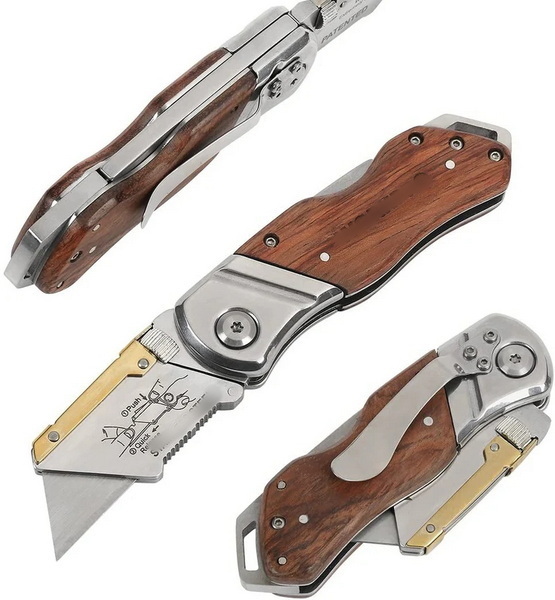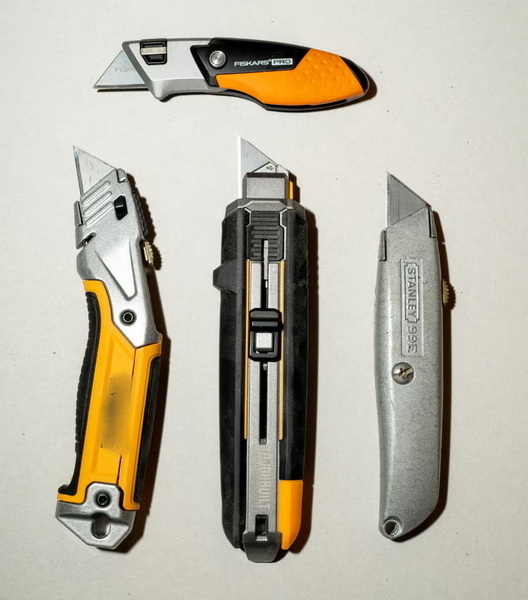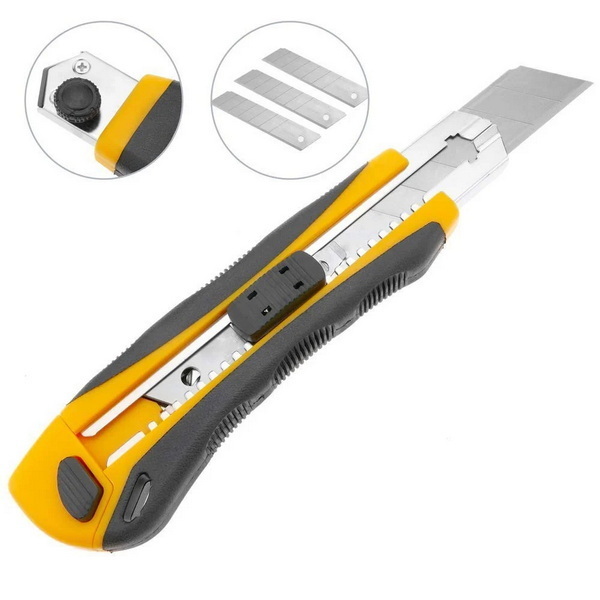Content Menu
● Understanding the Metal Folding Box Cutter Knife
● Safe Usage Practices for a Metal Folding Box Cutter Knife
>> 1. Inspect Your Knife Before Use
>> 2. Use the Right Blade Length
>> 3. Cut Away From Your Body
>> 4. Secure the Material Being Cut
>> 5. Maintain Focus and Avoid Distractions
>> 6. Wear Protective Gear
>> 7. Retract the Blade When Not in Use
>> 8. Pass the Knife Safely
● Additional Safety Tips for Using a Metal Folding Box Cutter Knife
>> 9. Avoid Using Excessive Force
>> 10. Be Mindful of Your Surroundings
>> 11. Use the Knife for Its Intended Purpose Only
● Proper Maintenance of Your Metal Folding Box Cutter Knife
>> Cleaning
>> Lubrication
>> Blade Replacement
● Extended Maintenance Advice
>> Checking the Folding Mechanism
>> Storing Spare Blades Safely
● Best Practices for Storing a Metal Folding Box Cutter Knife
>> 1. Store in a Dry, Cool Place
>> 2. Use Protective Sheaths or Cases
>> 3. Keep Out of Reach of Children
>> 4. Retract Blade Before Storage
>> 5. Regularly Inspect Stored Knives
● Additional Storage Recommendations
>> Avoid Extreme Temperatures
>> Label Your Storage Area
● Summary of Safety Tips
● Conclusion
● FAQ
>> 1. How often should I replace the blade in my metal folding box cutter knife?
>> 2. Can I use a metal folding box cutter knife without gloves?
>> 3. What is the safest way to pass a box cutter to someone else?
>> 4. How should I clean and maintain my metal folding box cutter knife?
>> 5. Where is the best place to store a metal folding box cutter knife?
Using and storing a metal folding box cutter knife safely is crucial to prevent injuries and maintain the tool's longevity. This versatile tool is widely used in homes, warehouses, and workplaces for cutting boxes, packaging materials, and other tasks. However, the sharp blade poses significant risks if handled improperly. This comprehensive guide will walk you through the best practices for safely using and storing your metal folding box cutter knife, ensuring both your safety and the tool's durability.

Understanding the Metal Folding Box Cutter Knife
A metal folding box cutter knife typically features a sharp, retractable blade housed in a metal handle that folds for compactness and safety. These knives are preferred for their durability and ease of use. The folding mechanism protects the blade when not in use, minimizing accidental cuts.
Safe Usage Practices for a Metal Folding Box Cutter Knife
1. Inspect Your Knife Before Use
Always check the knife before using it. Ensure the blade is sharp, clean, and securely locked in place. A dull blade requires more force to cut, increasing the risk of slips and injuries. Replace dull or damaged blades promptly to maintain cutting efficiency and safety.
2. Use the Right Blade Length
Extend only the portion of the blade necessary to cut through the material. Overextending the blade reduces control and increases the chance of accidents. Matching blade exposure to the thickness of the material improves leverage and safety.
3. Cut Away From Your Body
Always cut in a direction away from your body and hands. This reduces the risk of injury if the blade slips. Never cut towards yourself or others nearby.
4. Secure the Material Being Cut
Ensure the box or material you are cutting is stable and secured. Cutting on a moving or unstable surface can cause the blade to slip, leading to injuries or damage to the contents.
5. Maintain Focus and Avoid Distractions
Keep your full attention on the cutting task. Avoid multitasking or distractions while using the box cutter to prevent accidents.
6. Wear Protective Gear
Consider using cut-resistant gloves to reduce the severity of potential injuries. While gloves do not make you invincible, they provide an extra layer of protection.
7. Retract the Blade When Not in Use
Always retract the blade fully when you are not cutting. This simple step prevents accidental cuts and protects the blade from damage.
8. Pass the Knife Safely
When handing the knife to someone else, always pass it with the blade retracted and handle first. Never throw or toss the knife to a coworker.
Additional Safety Tips for Using a Metal Folding Box Cutter Knife
9. Avoid Using Excessive Force
Applying too much force when cutting can cause the blade to snap or slip, leading to injuries. Use steady, controlled pressure and let the sharp blade do the work.
10. Be Mindful of Your Surroundings
Ensure that your workspace is clear of obstacles and other people when using the box cutter. This reduces the risk of accidental injury to yourself and others.
11. Use the Knife for Its Intended Purpose Only
Avoid using the box cutter for tasks it is not designed for, such as prying or twisting, which can damage the blade and increase the risk of accidents.
Proper Maintenance of Your Metal Folding Box Cutter Knife
Cleaning
Regularly clean your knife to remove debris, adhesive residues, and dirt that can accumulate on the blade and folding mechanism. Use a cloth and mild cleaning solution if necessary. Dry the knife thoroughly to prevent rust.
Lubrication
Apply a small amount of lubricant to the folding joint to ensure smooth operation. This prevents the knife from sticking or folding unexpectedly during use.
Blade Replacement
Replace blades as soon as they become dull or damaged. Using a sharp blade reduces the force needed to cut and lowers the risk of accidents.

Extended Maintenance Advice
Checking the Folding Mechanism
Regularly test the folding mechanism to ensure it locks securely in both open and closed positions. A faulty lock can cause the blade to fold unexpectedly, posing a safety hazard.
Storing Spare Blades Safely
Keep spare blades in a secure container to prevent accidental cuts when handling or retrieving them. Avoid leaving loose blades in drawers or work areas.
Best Practices for Storing a Metal Folding Box Cutter Knife
1. Store in a Dry, Cool Place
Moisture can cause rust and corrosion on metal blades and handles. Store your folding box cutter in a dry, cool environment away from humidity and direct sunlight.
2. Use Protective Sheaths or Cases
If available, store the knife in a sheath or dedicated case to protect the blade and prevent accidental contact. This also helps avoid damage to the blade edge.
3. Keep Out of Reach of Children
Store the knife in a secure location, such as a locked drawer or toolbox, where children cannot access it.
4. Retract Blade Before Storage
Always ensure the blade is fully retracted before placing the knife in storage. This minimizes the risk of accidental cuts and blade damage.
5. Regularly Inspect Stored Knives
If knives are stored for long periods, inspect them regularly for rust or damage. Clean and lubricate as needed before use.
Additional Storage Recommendations
Avoid Extreme Temperatures
Do not store the knife in places with extreme heat or cold, as this can affect the metal's integrity and the folding mechanism. Extreme temperatures may cause metal fatigue or warping.
Label Your Storage Area
If you have multiple cutting tools, label their storage areas clearly to avoid confusion and ensure safe handling. Organized storage reduces the risk of grabbing the wrong tool and potential accidents.
Summary of Safety Tips
| Safety Aspect |
Best Practice |
| Blade Sharpness |
Keep blades sharp; replace dull blades promptly |
| Blade Exposure |
Extend only necessary blade length |
| Cutting Direction |
Always cut away from your body |
| Material Stability |
Secure the material before cutting |
| Focus |
Avoid distractions during use |
| Protective Gear |
Wear cut-resistant gloves if possible |
| Blade Retraction |
Retract blade when not in use |
| Passing the Knife |
Pass with blade retracted, handle first |
| Storage Environment |
Store in dry, cool place, away from children |
| Maintenance |
Clean, lubricate, and inspect regularly |
Conclusion
A metal folding box cutter knife is a practical and efficient tool when handled with care. Prioritizing safety by following proper usage techniques, maintaining the knife regularly, and storing it correctly will protect you from injuries and extend the life of your tool. Always respect the sharpness of the blade, keep your focus while cutting, and ensure the blade is safely retracted when not in use. By adopting these habits, you can confidently and safely use your metal folding box cutter knife for all your cutting needs.

FAQ
1. How often should I replace the blade in my metal folding box cutter knife?
You should replace the blade as soon as it becomes dull or damaged. A sharp blade requires less force to cut and reduces the risk of accidents. Regular inspection before use helps determine when replacement is necessary.
2. Can I use a metal folding box cutter knife without gloves?
While it is possible, wearing cut-resistant gloves is recommended to minimize injury risk. Gloves provide an extra layer of protection but do not replace careful handling and proper technique.
3. What is the safest way to pass a box cutter to someone else?
Always pass the box cutter with the blade fully retracted and the handle first. Never throw or hand it over with the blade extended to prevent accidental cuts.
4. How should I clean and maintain my metal folding box cutter knife?
Clean the blade and handle regularly to remove dirt and adhesive residues. Dry thoroughly to prevent rust. Lubricate the folding joint occasionally to ensure smooth operation. Replace blades when dull.
5. Where is the best place to store a metal folding box cutter knife?
Store the knife in a dry, cool place away from moisture and direct sunlight. Use a sheath or case if available, and keep it out of reach of children. Always retract the blade before storage.